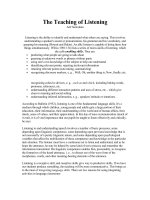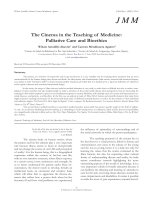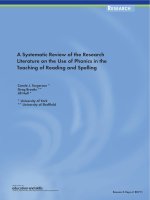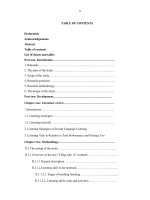THE AMBIGUITY IN THE TEACHING OF LISTENING COMPREHENSION
Bạn đang xem bản rút gọn của tài liệu. Xem và tải ngay bản đầy đủ của tài liệu tại đây (108.19 KB, 12 trang )
Vietnam National University, Ha Noi
UNIVERSITY OF LANGUAGES AND INTERNATIONAL STUDIES
POST-GRADUATE DEPARTMENT
THE AMBIGUITY IN THE TEACHING OF
LISTENING COMPREHENSION
(Final Assignment For Semantics)
Supervisor : Dr Hà Cẩm Tâm
Student : Trần Thị Phượng
Group
: K18C
Hanoi, 6/2010
TABLE OF CONTENTS
2.2.Structural Ambiguity..........................................................................................................................5
The abilities of language include listening, speaking, reading and writing. Listening
and reading is the way of language input. They are all active receptive skills, and
are the most important ways dependent on which people can get information from
the outside world. Listening is a more important one. But because of the limitation
of language and the optional nature of the response which shows people`s thought
of the outside world, sound language inevitably becomes to be uncertainty under
some definite circumstances. That is ambiguity. Ambiguity is a common
phenomenon of the language and language communication. The indefinite
characteristics of ambiguity is a common trammel that interferes with the learner`s
listening comprehension. To have a better understanding of the characteristics,
general rules of ambiguity and to master the basic ways of discriminating ambiguity
is helpful to the learners` semantic inference.
1. Ambiguity
1.1.
Ambiguity and Language
Tran Thi Phuong_K18C_HULIS_VNU
Page 2
The ways of language input are listening and reading. They are all receptive skills,
and are the most important ways dependent on which people can get information from
the outside world. Listening is a more important one .The nature of listening
comprehension is listener use language knowledge and background knowledge actively
to absorb and analyze the information , to understand exactly speaker`s meaning, to get
a thorough understanding of the whole conversation.
The teaching of listening comprehension aims at enlightening learners how to
understand the pure information contained by the sound symbols. Obviously, because
of the limitation of language and the optional nature of the response which shows
people`s thought of the outside world, sound language inevitably becomes to be
uncertainty under some definite circumstances. Thus, the ambiguity of sound language
often make learners who use English as the second language do not know how to
understand the pure information contained by the sound symbols. So, the ambiguity is
an important interference that should not be ignored in the teaching of listening
comprehension. The realization of the characteristic of the ambiguity and the basic
method of identification of ambiguity will improve the ability of student`s listening
comprehension.
Despite the fact that ambiguity in language is an essential part of language, it is
often an obstacle to be ignored or a problem to be solved for people to understand each
other. In any case, language ambiguity can be understood as an illustration of the
complexity of language itself.
1.2.
What Does Language Ambiguity Mean?
As a start, I will define some terms to clarify what we mean by “ambiguity”. By
defining “lexical and structural ambiguity,“ “connotation, denotation and implication
Ambiguity “,“Semantic Ambiguity“, “Syntactic Ambiguity“, “Pragmatic Ambiguity”,
Tran Thi Phuong_K18C_HULIS_VNU
Page 3
“Understanding ambiguity“, and so on , I will try to construct a base upon which
language ambiguity in listening comprehension takes on extra meaning.
Something is ambiguous when it can be understood in two or more possible senses
or ways. If the ambiguity is in a single word it is called lexical ambiguity. If the
ambiguity is in a sentence or clause, it is called structural ambiguity.
2. Two types of Ambiguity
2.1.
Lexical Ambiguity
Lexical ambiguity stems from the existence of homophony and polysemy.
Homophony occurs when a single word has more than one meaning. For example, the
word bank can be used to denote either a place where monetary exchange and handling
takes place or the land close river, the bank of the river.
Some other examples of homophony are: The word tin
•
This can is made of tin.
•
Put the left-over’s in the cookie tin.
The word tan
•
Anne went to Mexico and got a tan
•
My favorite jacket is black with a tan collar.
In these examples the context in which the sentences occur omits confusion that
homophony might have caused.
Homophony also occurs when a word that is not necessarily spelled the same but is
pronounced the same and used to have different meanings.
Tran Thi Phuong_K18C_HULIS_VNU
Page 4
For example, the words night and knight are pronounced exactly the same although
they are spelled differently, and they have very different meanings.
•
It gets very cold here at night.
•
The knight in shining armor saved the princess.
Polysemy occurs when a word, or small group of words, has two or more related
meanings. This may sound a lot like homophony, and it is true that they are related.
However, polysemy involves close relations between meanings of a single word,
where homophony may involve completely different meanings.
Some examples of polysemy are:
The verb to glare
•
The sun glared down from the hot desert sky.
•
The angry girl glared at the boy who had pulled her hair.
The word bright
•
The stars are bright tonight.
•
She must be very bright if she made an "A" on the test.
2.2.
Structural Ambiguity
Structural ambiguity occurs when a phrase or sentence has more than one
underlying structure, such as the phrases 'Tibetan history teacher', 'a student of high
moral principles' and 'short men and women', and the sentences 'The girl hit the boy
with a book' and 'Visiting relatives can be boring'. These ambiguities are said to be
structural because each such phrase can be represented in two structurally different
ways, e.g., '[Tibetan history] teacher' and 'Tibetan [history teacher]'. Indeed, the
Tran Thi Phuong_K18C_HULIS_VNU
Page 5
existence of such ambiguities provides strong evidence for a level of underlying
syntactic structure (see SYNTAX). Consider the structurally ambiguous sentence,
'The chicken is ready to eat', which could be used to describe either a hungry
chicken or a broiled chicken. It is arguable that the operative reading depends on
whether or not the implicit subject of the infinitive clause 'to eat' is tied
anaphorically to the subject ('the chicken') of the main clause.
It is not always clear when we have a case of structural ambiguity. Consider, for
example, the elliptical sentence, 'Perot knows a richer man than Trump'. It has two
meanings that Perot knows a man who is richer than Trump and that Perot knows man
who is richer than any man Trump knows, and is therefore ambiguous. But what about
the sentence 'John loves his mother and so does Bill'? It can be used to say either that
John loves John's mother and Bill loves Bill's mother or that John loves John's mother
and Bill loves John's mother. But is it really ambiguous? One might argue that the
clause 'so does Bill' is unambiguous and may be read unequivocally as saying in the
context that Bill does the same thing that John does, and although there are two
different possibilities for what counts as doing the same thing, these alternatives are not
fixed semantically. Hence the ambiguity is merely apparent and better described as
semantic under-determination
3. The basic methods of distinguishing ambiguity in teaching listening
comprehension
In fact, any language is based on certain idiomaticalness. In
formed in the people`s communication is largely depend on the cognitive ability of
the interaction between many factors in the usage of language. “It points out the
complexity and the unavoidable situation of Ambiguity, and idiomaticalness is the
key of knowing the pure information of Ambiguity. The logic of people`s thought
governs idiomaticalness that is the inter community in people`s language. The basic
Tran Thi Phuong_K18C_HULIS_VNU
Page 6
rule of listening comprehension is the unification of the sound and the meaning.
Only in this way, sound can contain the pure information. The learners should know
the idiomaticalness in English, the methods of logic, language circumstance, the
background of culture and the knowledge of tone and so on , for ambiguity often
disturb the unification.
3.1.
Getting rid of thinking model
As we all know that, different subjective world can result from the same
objective world. In other words, people`s observation and thinking models are
governed by the structure of language.
For example:
The sentence “Sitting in his pants” in Vietnamese means someone is wearing
in his/her pants. But in English it means bareness.
“.......eat one`s words” in Vietnamese means break one`s prom. but it means
acknowledge one`s mistake in English.
One`s mother tongue is gradually formed in certain circumstance , thus ,
he/she has been governed by fixed thinking methods of mother tongue. So, in
listening comprehension, it will be difficult to get rid of those fixed methods.
Therefore, learner should practice his/her thinking model in English positively.
3.2.
Griping the additional things of sounds
In communication, one can express his intention by pause, changing his tone,
mood and other expressing methods or by laughing, screaming, groaning, sighing
and so on. All of these are the additional thing of language, and they are very
important in distinguishing ambiguity in listening comprehension.
3.3.
Identifying the context
The meaning of sentence will change as the changing of the context. Context
means the circumstance of communication.
For example
“It is a square meal. “
The “square“ here means generous ,not a shape with four straight sides that
are the same length and four right angles, because there is a word “meal“ in the
sentence. This is the context. In sentence “The train was long. “ It is difficult to
Tran Thi Phuong_K18C_HULIS_VNU
Page 7
determine if the train means carriages or wagons that are pulled by an engine
along a railway line or just a skirt without certain context.
The organization of language depends much on context, and its variation
usually clings to given context. The speaker use correct speech in given context
to make the arrangement of his speech corresponds to certain context and social
background. The ordering of information depends on the grammar and logic
bases on national cultural background, and influenced by the given context.
Context gives word or sentence different meanings.
So in listening comprehension, we should distinguish context positively in
order to reduce the misunderstand of the ambiguity`s pure information.
3.4.
Knowing well about the background of social culture
Culture is the summation of material civilization as well as mental civilization
which is created in the long history by human being. Language should not break
from given civilization, which is the summation that is created in the long history of
human being and decides our observance and faith. Each language is enriched by
the nutrition which comes from certain culture and civilization. Each language has
its own characteristic.
In modern society, opportunities often arise for people to interact with others
from abroad. First-time visitors to foreign countries may find themselves a bit
surprised at the different lifestyles and cultural peculiarities they encounter.
For example:
The American form of address starts with the name of the individual first, then
the street name, the city and state and finally the nation. It shows that America is
built upon the premise of the value of the individual over and above the state and
nation.
Tran Thi Phuong_K18C_HULIS_VNU
Page 8
But the Vietnamese way of address stares with the name of nation first, the city
and the street, then the name of the individual. It shows that Viet Nam is built upon
the premise of the value of the nation, the state, and the group over the individual.
Moreover, what is seen as common saying in one culture may be constructed as
strange and even insulting in another culture? So it would form ambiguity without
the background of culture.
For example:
The need to show respect is universal. But how you show it is cultural. In
American , to show respect in a church on removes his hat , In Viet Nam, to show
respect in a mosque , one puts on his hat and removes his shoes . The result is the
same, but the habit is different.
Americans believe that high self-esteem and positive self-regard are signs of a
healthy individual. This positive self-regard often includes speaking about oneself,
one`s possessions and one`s talents in a self-flattering manner. On the other hand,
the act of bragging or boasting about oneself, one`s possessions or one`s talents is
viewed as extremely bad form by Vietnamese. The one who boasts is regarded as a
fool who does not know his or her limitations.
In the United States, one informal or casual kind of social gathering is a potluck.
At a potluck, each guest brings some food. To prevent guest bringing the same
dishes, the host or hostess sometimes suggests what kinds of food each guest should
bring. They do not want a party with 20 different pies or cakes and nothing else!
But in Vietnamese dictionaries, it is hard to find this word, “potluck. “ Usually, the
host or hostess needs to prepare everything, If you suggest your guest should bring
something to your party, a misunderstanding may occur
Tran Thi Phuong_K18C_HULIS_VNU
Page 9
So, it is very important to develop cross-cultural awareness in order to function
in listening comprehension.
For example:
In Vietnamese, we said “as strong as an elephant “, but in English we used to
say “as strong as a horse “. To express culture, language is an important method.
Specific culture and civilization can give certain characteristic to language.
The contents of civilizations are diversified, for each of them has a versatile
knowledge storehouse. People are living in definite national culture , For
Vietnamese learner ,the understanding of distinct cultural value of English depends
on the practice, which they did positively such as idiom, slang, and common saying
are all contain certain deep cultural value .We should not infer their meanings just
by their pronunciations.
The integration of pronunciation and meaning is not inherent but depends on the
determination of given social culture and custom arranged by idiomaticalness. In
the teaching of listening comprehension, be familiar with each idiomaticalness is
the foundation of distinguishing ambiguity.
4. Conclusion
Language cannot exist without ambiguity; which has represented both a curse and a
blessing through the ages. Since there is no one “truth“ and no absolutes, we can
only rely on relative truths arising from groups of people who, within their
particular cultural systems, attempt to answer their own questions and meet their
needs for survival.
Language is a very complex phenomenon. Meanings that can be taken for
granted are in fact only the tip of a huge iceberg. Psychological, social and cultural
events provide a moving ground on which those meanings take root and expand
their branches.
Tran Thi Phuong_K18C_HULIS_VNU
Page 10
Ambiguity is an eternal phenomenon of language, which is changing frequently.
So for the learner whose thinking model and logical model has been governed by
his mother tongue, repeated practice is important, for getting the feeling of
language. He should also do some valuable analysis’s on ambiguity in order to
know the common rules of ambiguity and to learn how to distinguish it. In other
words, he should use both “meaning” and “logic” as the foundation and reference.
Only by comparing the meaning of concept, referring the meaning of
association, understanding the meaning of context, mastering the meaning of
culture, can learner conquers the problems in listening comprehension brought by
ambiguity. So the ambiguity in the teaching of listening comprehension should not
be ignored.
5. References
[1] Durant, A & C. Goodwin . Rethinking Context [M]. London :CUP ,1992.
[2] Sperber, D & D , Wilson . Relevance [M] . Oxford: Basil Blackwell Ltd ,
1986.
[3] Cumperz, J. C. Language and Social Identity [M] . Cambridge : CUP, 1982
[4] Brown . G . Modes of Understanding . In Language and Understanding
Oxford university Pre . 1994.
[5] Websites:
/> />CRETRY=1&SR /> /> ambiguity.htm
Tran Thi Phuong_K18C_HULIS_VNU
Page 11






